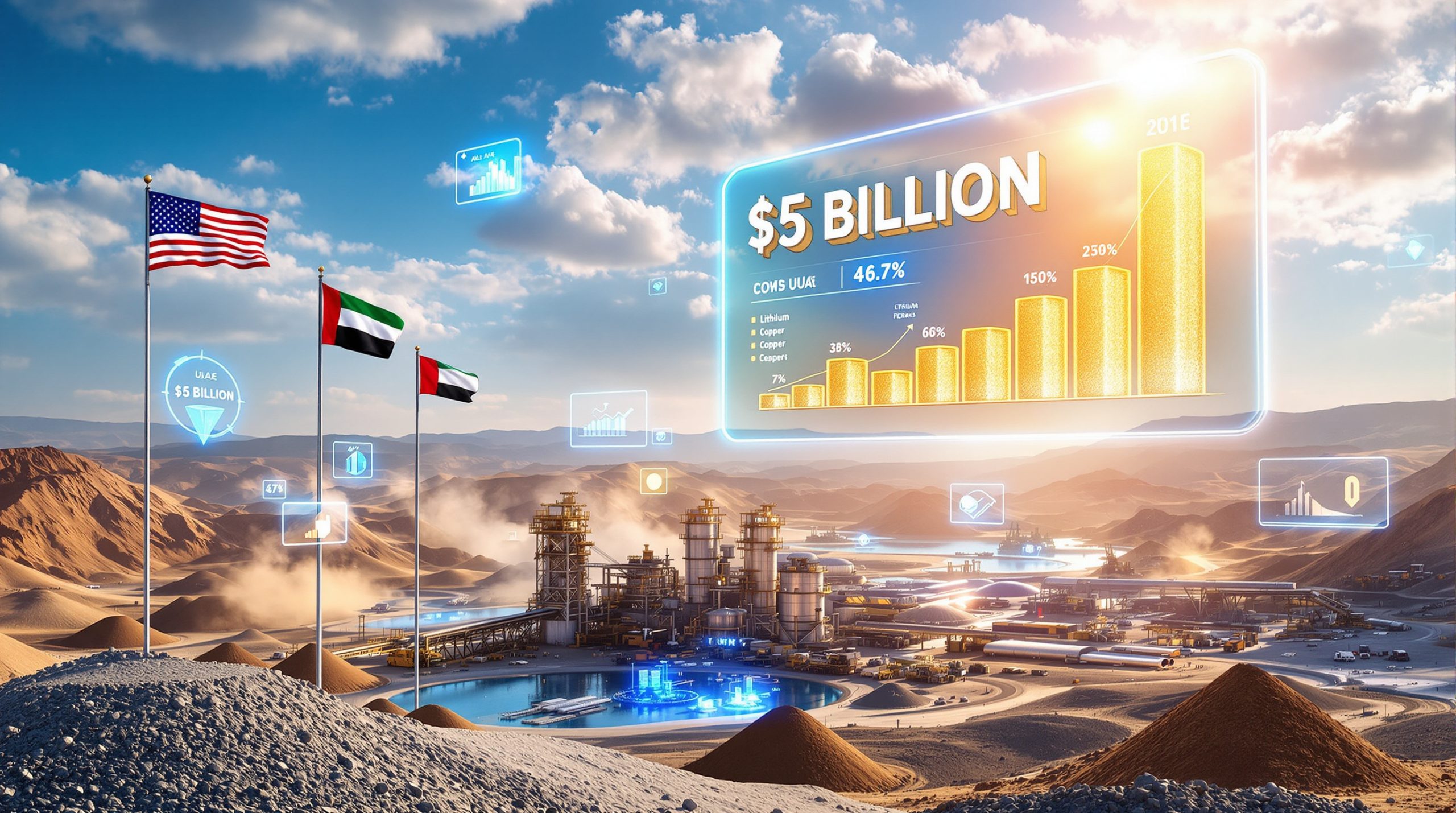What Are Strategic Minerals and Why Do They Matter?
Strategic minerals are raw materials deemed essential for a nation's economic and national security. In the United States, these minerals play a crucial role in various industries, from defense and aerospace to renewable energy and automotive manufacturing. The challenge? The U.S. currently imports a significant percentage of these critical minerals, creating vulnerabilities in supply chains and national security.
According to Mark Smith, CEO of NioCorp Developments, "This mine is desperately needed in the United States… We import 100% of the niobium and scandium we need." This stark reality highlights the urgency of addressing America's strategic mineral dependencies.
Defining Strategic Minerals in the U.S. Context
Strategic minerals are non-fuel mineral resources that:
- Are essential for economic prosperity and national defense
- Face supply chain vulnerabilities due to limited domestic production
- Are subject to potential supply disruptions from geopolitical tensions
- Have few or no viable substitutes in their applications
The Strategic Vulnerability Gap
Currently, the United States faces significant import dependencies for numerous critical minerals:
- 100% import reliance for niobium
- 100% import reliance for scandium
- 75% import reliance for titanium
- Near-total import reliance for magnetic rare earth oxides
- Heavy reliance on China for processing many of these materials
The statistics paint a concerning picture: China controls approximately 60% of global titanium processing and dominates rare earth production and refinement. These dependencies create strategic vulnerabilities that extend beyond economics into national security concerns.
How Are Strategic Minerals Used in Key Industries?
Strategic minerals serve as the foundation for numerous advanced technologies and applications across multiple sectors of the U.S. economy, with their importance growing as technology advances.
Defense Applications
Strategic minerals are essential components in military hardware:
- Titanium: Comprises approximately 80% of F-22 fighter jet weight
- Rare earth elements: Critical for guidance systems in missiles and submarines
- Niobium: Used in high-strength steel alloys for military infrastructure and vehicles
- Scandium: Enhances aluminum alloys used in aerospace applications
As Mark Smith explains, these materials are not merely beneficial but often irreplaceable in defense applications: "You simply cannot build certain defense systems without these specific elements."
Automotive and Transportation
The transportation sector increasingly relies on strategic minerals:
- Scandium-aluminum alloys: Provide lighter, stronger, more corrosion-resistant vehicle chassis
- Rare earth magnets: Essential for electric vehicle motors
- Titanium: Used in high-performance vehicle components
- Niobium: Incorporated into high-strength, low-alloy steels for structural components
Smith notes that "Scandium does for aluminum what niobium does for steel," enabling significant weight reduction and performance improvements that directly impact EV battery efficiency and range.
Renewable Energy Infrastructure
The green energy transition depends heavily on energy transition minerals:
- Rare earth elements: Required for wind turbine generators
- Niobium: Used in high-strength steel for infrastructure projects
- Titanium: Component in various renewable energy systems
- Scandium: Potential applications in fuel cells and energy storage
Global manufacturers recognize this critical need. Thyssenkrupp of Germany has already secured a 50% offtake agreement for NioCorp's future niobium production, demonstrating the international competition for these resources.
Which Strategic Minerals Is the U.S. Most Dependent On?
The United States faces critical supply vulnerabilities across several key mineral categories, with some dependencies reaching 100%.
Rare Earth Elements
Rare earth elements (REEs) represent perhaps the most significant strategic vulnerability:
- Magnetic Rare Earths: Neodymium, praseodymium, dysprosium, and terbium are essential for permanent magnets used in electric vehicles, wind turbines, and defense applications
- Heavy Rare Earths: Dysprosium and terbium are particularly critical for high-temperature applications
- Supply Challenge: China controls approximately 60% of global rare earth production and approximately 90% of processing capacity
- U.S. Status: Currently imports virtually all magnetic rare earth oxides
According to Smith, "We have zero [heavy rare earths like dysprosium] produced in the U.S. today," a situation that creates extreme vulnerability for high-tech manufacturing.
Niobium
Niobium represents another critical vulnerability:
- Key Applications: Adding just one pound of niobium to a ton of steel can double its yield strength, making it essential for infrastructure and construction
- Market Dynamics: Demand remains strong in both public infrastructure projects and private construction
- U.S. Status: 100% import dependent, with no domestic production
The strength-to-weight benefits of niobium-enhanced steel cannot be overstated. This metal enables everything from safer vehicles to more resilient infrastructure, yet the U.S. has no domestic production.
Scandium
This lesser-known but increasingly important mineral faces complete import dependence:
- Key Applications: Strengthens aluminum alloys, making them lighter, more corrosion-resistant, and weldable
- Emerging Markets: Aerospace, automotive, and sporting goods industries
- U.S. Status: 100% import reliant with virtually no domestic production
Smith emphasizes that scandium-aluminum alloys enable "robotic welding in aerospace manufacturing," a critical capability for advanced manufacturing processes.
Titanium
While less import-dependent than other minerals, titanium still presents challenges:
- Key Applications: Critical for aerospace, defense, medical devices, and industrial applications
- Supply Concerns: Growing Chinese market share (approximately 60%) and control of processing
- U.S. Status: Imports approximately 75% of needed titanium
What Initiatives Are Addressing Strategic Mineral Vulnerabilities?
The United States has begun implementing various strategies to address critical mineral supply vulnerabilities, combining policy actions with private sector investments.
Government Policy Actions
Recent policy initiatives aim to strengthen domestic supply chains:
- Executive Orders: Presidential executive orders specifically addressing critical and strategic minerals, including those issued under the Trump administration
- Federal Agency Implementation: Government agencies actively working to execute these directives
- Funding Initiatives: Increased financial support for domestic mining and processing projects
- Regulatory Streamlining: Efforts to reduce permitting timelines while maintaining environmental standards
Smith notes that "The Trump administration is prioritizing projects like ours to reduce reliance on China," reflecting the growing bipartisan consensus that strategic mineral independence requires governmental support.
Public-Private Partnerships
Collaboration between government and industry is accelerating:
- Export-Import Bank Financing: The U.S. EXIM Bank has approved $800 million in debt financing for projects like NioCorp's Nebraska development
- Department of Energy Programs: Supporting research and development in extraction and processing
- Industry Engagement: Increased coordination between government agencies and private companies
These partnerships are critical because, as Smith explains, "Traditional mining finance has dried up… EXIM Bank's additionality clause is critical" for projects that might otherwise struggle to secure funding.
Domestic Mining and Processing Development
New projects are emerging to address supply vulnerabilities:
- Nebraska Carbonatite Project: A significant development that will produce niobium, scandium, titanium, and rare earth elements
- Processing Facilities: Investments in domestic processing capabilities to reduce reliance on foreign midstream operations
- Technology Innovation: Development of more efficient extraction and separation methods
The Nebraska project's technical innovation is particularly notable, using hydrometallurgy to recover rare earth oxides at approximately 92% efficiency, according to pilot plant results.
How Do International Partnerships Factor Into U.S. Strategy?
The United States isn't approaching strategic mineral security in isolation, recognizing that international collaboration strengthens the entire supply chain.
Allied Nation Cooperation
Partnerships with friendly nations are a key component:
- European Collaborations: Agreements with European manufacturers and processors
- Five Eyes Partnerships: Coordination with Australia, Canada, New Zealand, and the UK
- Japan and South Korea: Technology sharing and supply chain integration with Asian allies
Smith emphasizes that strategic mineral security isn't exclusively about domestic self-sufficiency: "We're not U.S.-centric… half our niobium goes to Germany, but we're also addressing U.S. needs."
Global Offtake Agreements
U.S. producers are establishing international supply relationships:
- European Industrial Contracts: 50% of NioCorp's niobium allocated to Thyssenkrupp (Germany)
- Automotive Sector Partnerships: Collaboration with Stellantis for EV rare earth supply
- Aerospace Industry Connections: Supply arrangements with international aerospace manufacturers
These offtake agreements often include price collars to manage market volatility, providing stability for both producers and consumers in an often-volatile commodity market.
What Challenges Remain in Securing Strategic Mineral Supply Chains?
Despite progress, significant obstacles remain in establishing secure supply chains for strategic minerals in the United States.
Financial Hurdles
Funding remains a major challenge:
- High Capital Requirements: Projects often require investments of $1 billion or more
- Limited Commercial Financing: Traditional mining finance has become more difficult to secure
- Long Payback Periods: Extended timelines for return on investment
- Market Volatility: Price fluctuations can complicate project economics
The scale of required investment cannot be overstated. As Smith notes, mining projects require "approximately $1 billion-plus investments with 7-10-year timelines" before generating returns.
Technical Expertise Gaps
Knowledge and skills shortages present obstacles:
- Processing Know-How: Limited domestic expertise in processing certain minerals, particularly rare earths
- Workforce Development: Need for trained professionals in mining and processing
- Research and Development: Ongoing requirements for technological innovation
China's decades-long dominance in processing (controlling approximately 80% of rare earth refining) has created a knowledge gap that requires concerted educational and workforce development efforts to overcome.
Geopolitical Complexities
International dynamics continue to impact strategic mineral security:
- Chinese Market Dominance: China's control of significant portions of the supply chain
- Russian Supply Disruptions: Impacts from sanctions and conflict
- Shifting Trade Relationships: Evolving international trade policies and agreements
What Does the Future Hold for U.S. Strategic Mineral Security?
Looking ahead, several trends will shape the strategic minerals landscape in the United States over the coming decade.
Emerging Domestic Projects
New developments are on the horizon:
- Nebraska Carbonatite: Expected to begin production within 3-4 years after financing is secured
- Other Rare Earth Projects: Additional mines and processing facilities in development
- Recycling Initiatives: Growing focus on recovering strategic minerals from waste streams, potentially supplying 10-20% of U.S. rare earth demand by 2030
Smith acknowledges that "Recycling is a growing opportunity… but scale remains limited" in the near term, while emphasizing its long-term potential.
Technological Innovations
Advances in technology will impact strategic mineral utilization:
- Substitution Research: Development of alternatives for some critical minerals
- Efficiency Improvements: Technologies that reduce the amount of strategic minerals needed
- Novel Extraction Methods: More environmentally friendly and cost-effective mining innovations
NioCorp's project demonstrates this innovation, avoiding a sulfuric acid plant in its processing design, saving approximately $100 million in capital costs while maintaining performance.
Policy Evolution
Government approaches continue to develop:
- Long-term Strategy Implementation: Moving from planning to execution phases
- Public-Private Coordination: Deepening relationships between government and industry
- International Framework Development: Establishing more robust cooperation with allies
How Can the U.S. Achieve Greater Strategic Mineral Independence?
Achieving greater security will require a multifaceted approach combining domestic development, international partnerships, and technological innovation.
Diversifying Supply Sources
Reducing dependency on any single source:
- Domestic Production Expansion: Developing new mines and processing facilities within the U.S.
- Allied Nation Sourcing: Increasing imports from friendly countries
- Secondary Recovery: Extracting minerals from mine tailings, industrial waste, and recycled materials
Industry experts project that building domestic processing infrastructure could reduce midstream reliance on China by 50% by 2035, though this requires sustained investment and policy support.
Investing in Processing Infrastructure
Addressing the critical midstream vulnerability:
- Separation Facilities: Building domestic capacity for separating and processing rare earths
- Metallurgical Capabilities: Developing facilities to convert minerals into usable forms
- Vertical Integration: Supporting projects that include both mining and processing
Smith emphasizes that "Vertical integration—mining and processing—is key to cutting China's control" of the strategic minerals supply chain.
Supporting Innovation and Research
Advancing technological solutions:
- Alternative Materials Research: Developing substitutes for the most vulnerable minerals
- Process Efficiency: Improving extraction and processing methods
- Recycling Technologies: Enhancing capabilities to recover strategic minerals from end-of-life products
Australia's Lynas Rare Earths provides a potential model with its mine-to-magnet supply chain approach, demonstrating how vertical integration can create resilience.
FAQs About Strategic Minerals in the United States
What makes a mineral "strategic" for the United States?
A mineral is considered strategic when it's essential for economic and national security, has limited domestic production, faces potential supply disruptions, and has few viable substitutes. The designation may change over time as technologies and geopolitical situations evolve, according to the US Geological Survey.
Why doesn't the U.S. already produce these minerals domestically?
Several factors have limited domestic production, including:
- Economic considerations that favored lower-cost foreign sources
- Complex permitting processes
- Environmental concerns
- Lack of processing infrastructure
- Limited investment in exploration and development
How long does it take to develop a new strategic mineral mine?
Developing a new mine typically takes 7-10 years from discovery to production, including:
- 2-3 years for exploration and resource definition
- 2-3 years for permitting and approvals
- 3-4 years for construction and commissioning
How do strategic minerals impact everyday consumer products?
Strategic minerals are components in numerous consumer products:
- Smartphones and computers (rare earths in speakers, vibration motors, and screens)
- Electric vehicles (rare earths in motors, niobium in steel components)
- Aircraft (titanium in structural components)
- Medical devices (titanium in implants and surgical tools)
- Sporting equipment (scandium in high-performance bike frames and baseball bats)
What role does recycling play in strategic mineral security?
Recycling offers a growing opportunity to recover strategic minerals from:
- End-of-life consumer electronics
- Industrial scrap and waste
- Spent catalysts and batteries
- Military equipment
- Automotive components
While currently limited in scale, recycling technologies are advancing rapidly and could provide a significant domestic source of strategic minerals in the future, as highlighted by the Center for Strategic and International Studies.
Disclaimer: This article contains forward-looking statements regarding mineral development projects, government policies, and market trends. These statements involve risks and uncertainties, and actual outcomes may differ from those projected. Investment decisions should be made based on comprehensive due diligence beyond the information presented here.
Want to Know When the Next Major Mineral Discovery Happens?
Don't miss out on potentially lucrative ASX mineral discovery announcements as they occur. Discovery Alert's proprietary Discovery IQ model delivers instant, actionable notifications on significant discoveries, giving you a crucial edge in the market. Visit our discoveries page to see how major mineral discoveries have historically led to substantial returns.




